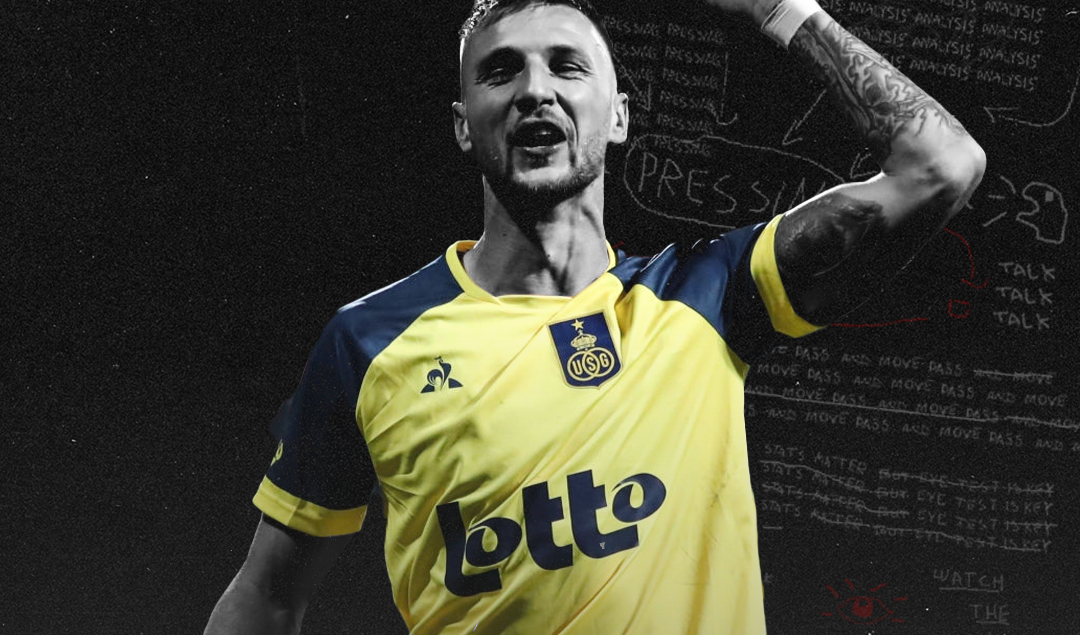Royale Union Saint-Gilloise: Belgium’s Lazarus
On March 13, 2021, Royale Union Saint-Gilloise defeated local rivals RWD Molenbeek 2-1 via goals from Deniz Undav and Guillaume François to secure promotion and end a 48-year absence from Belgium’s top-flight. Two years later, they find themselves in European competition for the first time in 58 years and have enjoyed a miraculous run that has seen them finish atop their Europa League group and defeat Union Berlin in the Round of 16, setting up a quarterfinals match-up with Bayer Leverkusen. They also sit second in the league, three points behind Genk, and are chasing their first league title since 1934/35.
Founded in Brussels in 1897, Union only had a short wait, until 1904, before they could get their hands on their first league title. From there seven more titles were added to Union’s trophy cabinet up until the First World War halted the beautiful game across Europe, as well as multiple European trophies. These friendly trophies were at points dominated by the Belgian team, winning consecutive editions on some occasions.
After the Great War, Union picked up where they left off, winning seven more league titles and on many occasions supplying the core of the Belgian national team, most notably during the 1934 World Cup. At that time, Union went 60 games unbeaten in the league, from 1933 to 1935, a record that stands to this day. After the Second World War, their success began to dim, with some spells in the Inter-Cities Fairs Cup during the late 50s and early 60s.
In the 1960 edition, they even reached the semifinals, knocking out AS Roma in the process. In 1963, however, it all came to a grinding halt, with Union being relegated to the second tier. Further relegations followed during the 80s, with their fanbase dwindling and their stadium falling into disrepair. Just three miles away, Anderlecht had already become the giant of Belgian football we know today. The Joseph Marien Stadium, a state-of-the-art venue when it opened in 1919, had remained virtually unchanged since 1926.
Just as Union were languishing in the lower leagues and their players had to train in a facility with no showers or toilets, Tony Bloom was just about to take Brighton to the Premier League. Bloom and his business partner Alex Muzio had been wanting to explore the multi-club ownership model and were scouting prospective teams. Union’s name came up, being put up for sale, and filled the criteria of proximity to England as well as being a fertile ground for young footballers looking to make an impact in Europe.
On 21 May 2018, Tony Bloom was confirmed as the majority shareholder with 90% of the club. Alex Muzio, the Chairman of Union, was a co-investor with Tony Bloom in 2018 and holds a minority interest in the club, but is tasked with the day-to-day running of the club. This day-to-day running employs a heavy focus on data-driven scouting, copying the model used at Brighton with so much success. Moreover, this Brighton link is something that is worth exploring.
The Belgian league has been historically tied to the English game with various Premier League sides having either partnerships with or outright owning Belgian clubs. Manchester United collaborated with Royal Antwerp and Leicester City’s King Power group also own OH Leuven. The draw of the Belgian league lies in its openness, with even established giants like Anderlecht not being outright dominant and European football being attainable for almost all top-half teams.
This meant that any Premier League club looking to loan out youngsters to a league where they could shine and play in European competitions, whilst at the same time giving their partner club a sporting and indeed financial advantage, needed to look no further than Belgium. This has become even more important, with the new rules regarding player acquisition brought in by Brexit, especially regarding under-18 players.
Bloom and Muzio have reshuffled the thinking towards England-based ownership of Belgian teams, not wanting simply to create a feeder squad a hundred miles away, but a self-sustaining football club. This is why after 2018 Union did not receive hundreds of millions in investment, or take on half of the Brighton squad on loan. Instead, the club took more of a turtle approach, painstakingly scouting underappreciated and undervalued players.
These players usually came from other lower-tier European leagues, where other, bigger clubs, wouldn’t be caught dead shopping. This helped them slowly but surely climb up the second league table, and at the end of the 2020-21 season, they achieved promotion. Their approach was so effective, that Union, without massive investment finished first in the regular season in the Pro League in their first season back.
Players like Deniz Undav, Dante Vanzeir and Kaoru Mitoma shone for Union as they nearly pulled a Kaiserslautern. Sadly for Union, Club Brugge took home the crown at the end of the playoffs, but their amazing result unlocked European football for them.
Meanwhile, behind the scenes, the light touch of the Bloom Muzio regime carried out renovations to their historic ground and provided the club with a 20 million pound interest-free loan. With European football on the horizon, plans are being made for further investment in a state-of-the-art stadium, training facilities and youth academy. This rethinking of club ownership, where sporting achievements are put first, helped Union ingratiate themselves to not only the natives of Brussels, but to the wider footballing world.
Whilst Union Berlin are the poster child for the values and potency of the 50+1 ownership rule, the same can be said about Union Saint Gilloise, regarding healthy ownership and investment by a majority owner. As things are looking, with a few more years of top-three finishes and forays into European football, USG could become the dominant force in Belgian football, on both the footballing and financial fronts.
By: Eduard Holdis / @He_Ftbl
Featured Image: @GabFoligno / Isosport / MB Media / Getty Images
